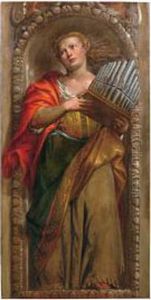Giambattista Zelotti Paintings
Giambattista Zelotti, also known as Battista Farinati or Battista Dello Zelotti, was an Italian painter of the Renaissance period, born in Verona in 1526. He was a contemporary and, in some instances, a collaborator with the more widely recognized Paolo Veronese and Alessandro Turchi. Zelotti's works are often characterized by their vibrant color palette and dynamic compositions, embodying the Venetian school's rich artistic traditions.
Zelotti's early training is somewhat obscure, but it is believed that he was initially a pupil of Antonio Badile, an important Veronese painter, and later might have studied with Giovanni Francesco Caroto. His association with Paolo Veronese began around the 1550s, and together they worked on several significant projects, including the frescoes for the Villa Barbaro at Maser, designed by the renowned architect Andrea Palladio. This collaboration is a testament to Zelotti's skill and adaptability, as he was able to complement Veronese's style effectively, contributing to the creation of cohesive and harmonious artworks.
Throughout his career, Zelotti was highly sought after for his expertise in fresco painting, receiving commissions from many prestigious clients. His work included religious compositions, mythological scenes, and allegorical subjects, which he executed with a masterful understanding of narrative and emotion. Zelotti's frescoes can be found in various villas and churches across the Veneto region, showcasing his ability to work on a grand scale and his sensitivity to architectural settings.
Zelotti's contributions to the art world, however, have often been overshadowed by the fame of his contemporaries, such as Veronese and Titian. Despite this, he played a vital role in the development of the Venetian Renaissance, influencing the use of color and the integration of architecture and painting. His works, characterized by their elegance and expressiveness, continue to be studied for their artistic and historical significance.
Giambattista Zelotti died in 1578, leaving behind a legacy that, while not as well-documented as some of his peers, is integral to understanding the richness and diversity of Renaissance art in Venice. His ability to convey complex narratives through vivid imagery and his contributions to the decorative arts mark him as a significant figure in the history of Italian art.

